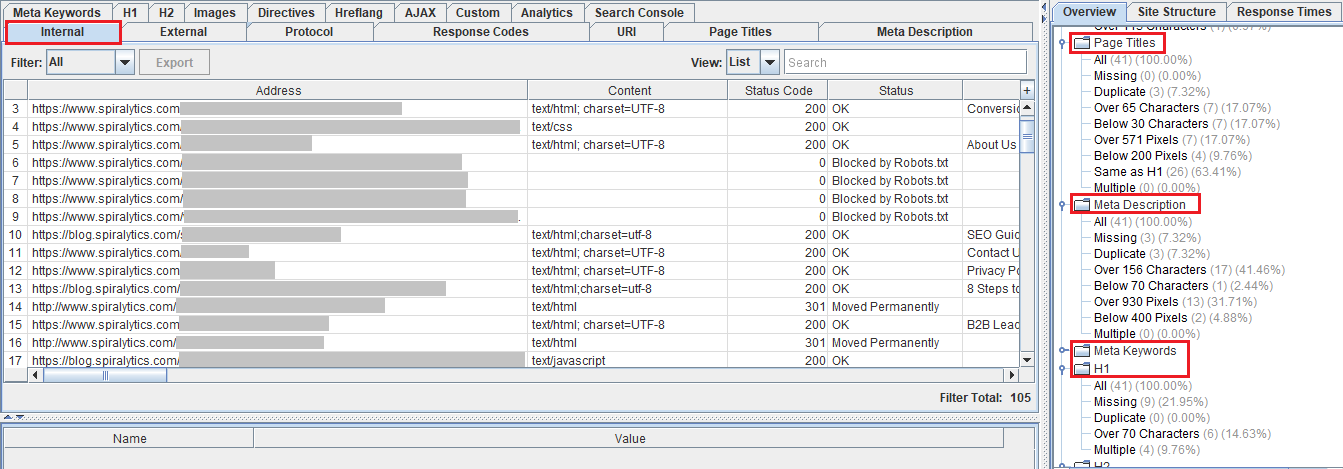This post is Stage 3 in our complete guide to search engine optimization.
Click here for the Full SEO Guide.
At this point, you’re probably already confident about your keyword research and competitor analysis efforts. The next thing to do is to perform an SEO audit.
SEO audits are necessary to evaluate the current standing of your website’s strategy based on top SEO metrics. You can check how search engine-friendly your site is in a range of categories. After your audit, you’ll likely be able to spot gaps or errors in your current efforts and fix these SEO issues to boost your standing.
In this blog post, you’ll learn how to perform this yourself. If you want a professional to accomplish this for you the first time around, you can check out our free SEO audit service.
It’s recommended to do SEO audits on your website regularly, perhaps biannually. Google continually makes changes and updates to its ranking algorithm, and SEO audits can help you spot those—as well as stay on top of your game.
How to Perform an Effective SEO Audit
You’ll be needing some tools for your SEO audit. You may choose to follow along with the tools below or use the equivalent of what you already have for your website.
If you’re ready, then let’s get to it!
Step One: Check for Google Penalties
Has Google penalized your website? If yes, find out when the penalty was imposed and what you can do to remove them. There are two ways to check:
-
Use Google Search Console and select your website. Choose ‘Manual Actions’ on the menu and wait for the report to display. If things look good, you should see ‘No issues detected’ on your screen.
-
Survey your page traffic via Google Analytics on the dates Google released changes to their algorithm. If there’s a big dip, chances are your website could have been affected.
Detect the source of your penalty and fix them while working on your SEO audit. If you don’t have penalties, pat yourself on the back and move on to the second step.
Step Two: Check your search appearance
This is a basic step, but one you need to pay attention to. When people search for your brand, you have to make sure that relevant and accurate information shows up on the first page, such as your website, pages, and descriptions. You should be the top hit. And if you’re not up there, that already indicates that you can enhance to your SEO strategy further, particularly your homepage and site structure.
Step Three: Perform a Technical SEO audit
This part of the audit will allow you to discover your site health and technical performance. There are a few things to check out here, such as indexed pages, ranking keywords, mobile usability, and more. Here are some of the things that should be of top concern:
-
Site speed
According to a Google study, a one-second delay in website load times can affect as much as 20% of your conversions. Therefore, it’s important to diagnose any site speed issues. You can use tools such as Google PageSpeed Insights for this. Go beyond analyzing your homepage. Dig deep and go through your blog posts and category pages as well.
Tip: Get your site loading faster by crunching your images. HD images can take a long time to load, causing the rest of your page performance to suffer.
-
Mobile friendliness
Being mobile-friendly is a huge factor in SEO now. After all, 60% of all searches come from a mobile device. Google has an easy-to-use online Mobile-Friendly Test tool that’ll quickly point out any areas that need optimization.
-
SEO Friendly URLs
Review your URL structure and make sure that your site URLs are unique with proper formatting.
- Bad example: https://bad.com/287/bad-url/289432794?
- Good example: https://good.com/proper-url
Your website should also be HTTPS secured, which means you have a beefed-up security certificate. This is a ranking signal and plays a significant advantage over non-secure or HTTP only sites.
Step Four: Perform an On-Page SEO audit
Web text and photos contribute to your SEO rankings and should be part of your audit. Here, you’ll look at copy, content, user interface, links, and more. At this stage, Screaming Frog’s SEO Crawler is one of the best tools you can use for a holistic on-page analysis. Right off the bat, it’ll present you with a list of optimization issues you can address immediately. If you’re able to resolve all these issues, you should feel pretty good about your website’s SEO, at least as far as on-page elements are concerned.

-
SEO-friendly titles and descriptions – Are your site titles and page descriptions unique? Do they follow the specified word or character count? Is it free from errors, and is easy to understand?
-
Check your text formatting – You also have to be mindful of how you bold, italicize and create your headings. Having uniform plain text on your page can hurt your SEO.
-
SEO-friendly content – Make sure you have original, high-quality content published on your website. Steer clear of plagiarism and be meticulous about editing your pieces. Check Google Analytics as to which pages have the highest traffic and try to produce more of those. It’s also a good idea to update any old articles that are still receiving high traffic.
-
Check your internal links – It’s good practice to link pages within your website. Keep your eyes peeled for any broken links and fix them right away. When in doubt, check out HubSpot’s take on pillar and cluster pages for optimizing site authority.
-
Image SEO – Yes, photos have SEO, too. Don’t just randomly upload them on your site: use descriptive naming conventions and have an ALT text for when photos take too long to load (or don’t load at all). Google crawls this text as well.
- Outdated content – Search engines and visitors want fresh content because the more recent something is, the more likely it is to contain updated information. Update your website content regularly to keep things relevant and timely. Apart from SEO, fresh content gives your visitors a new reason to come back—an opportunity to convert them into leads.
Step Five: Perform an Off-Page SEO audit
Lastly, off-page SEO will dive deep into the status of your backlinks. You’re looking for any standout issues on your site’s backlink profile.
On Ahrefs, click Site Explorer and go to Overview.
Check your Referring domains graph. A steady, upward increase is a good sign. This means the number of your backlinks are steadily increasing. If the line plateaus or goes down, it’s time to strengthen your backlink efforts.
Next, scroll down to Anchors. This portion will give you an idea of your website’s anchor text distribution.
Generally, it’s good to see anchor texts that are related to your business, such as your name (Spiralytics) and industry (content marketing). It helps build trust to your site.
Lastly, you’ll take a look at your website’s referring domains. On the Site Explorer, select Referring Domains and Sort by DR (lowest first).
If anything looks like a spam website, click on the number under the Links to Target column. This will reveal the backlinks where your site was mentioned.
Remove bad links from your profile as they can hurt your SEO standing.
That’s It!
There you have it: A basic execution of an SEO audit.
SEO is a big machine with lots of gears. An SEO audit can help in ensuring that your strategy stays updated for yet another ride. Whether you’re a small business or an established corporation in the industry, regular SEO audits can help you better your link-building techniques, boost your ranking, and analyze what you can be doing better.
This step-by-step SEO audit will help you continually refine your strategy and improve your search engine visibility. As many more businesses enter the digital sphere, it’s crucial to stay competitive in your industry.
This blog post is part of our “SEO Guide Series.” Stay tuned for our next post about on-page optimization.







